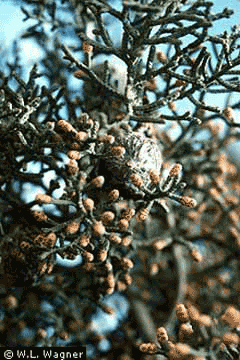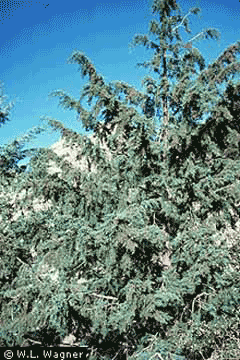 |
|
W.L. Wagner @ USDA-NRCS PLANTS Database |
 |
| W.L. Wagner @ USDA-NRCS PLANTS Database |
Translate this page:
Summary
Physical Characteristics

 Cupressus arizonica is an evergreen Tree growing to 25 m (82ft 0in) at a medium rate.
Cupressus arizonica is an evergreen Tree growing to 25 m (82ft 0in) at a medium rate.
See above for USDA hardiness. It is hardy to UK zone 7. It is in leaf all year, in flower from August to September, and the seeds ripen in October. The species is monoecious (individual flowers are either male or female, but both sexes can be found on the same plant) and is pollinated by Wind.
Suitable for: light (sandy), medium (loamy) and heavy (clay) soils, prefers well-drained soil and can grow in nutritionally poor soil. Suitable pH: mildly acid, neutral and basic (mildly alkaline) soils and can grow in very acid and very alkaline soils.
It cannot grow in the shade. It prefers dry or moist soil and can tolerate drought.
UK Hardiness Map
US Hardiness Map
Synonyms
Plant Habitats
Woodland Garden Canopy;
Edible Uses
References More on Edible Uses
Medicinal Uses
Plants For A Future can not take any responsibility for any adverse effects from the use of plants. Always seek advice from a professional before using a plant medicinally.
None known
References More on Medicinal Uses
The Bookshop: Edible Plant Books
Our Latest books on Perennial Plants For Food Forests and Permaculture Gardens in paperback or digital formats.

Edible Tropical Plants
Food Forest Plants for Hotter Conditions: 250+ Plants For Tropical Food Forests & Permaculture Gardens.
More

Edible Temperate Plants
Plants for Your Food Forest: 500 Plants for Temperate Food Forests & Permaculture Gardens.
More

More Books
PFAF have eight books available in paperback and digital formats. Browse the shop for more information.
Shop Now
Other Uses
Fuel Soil stabilization Wood
Trees are very drought tolerant and are planted on slopes in its native range in order to prevent soil erosion[229]. Wood - soft, close-grained[61]. Hard, heavy and durable according to another report[229]. Used for general construction and fuel[61].
Special Uses
References More on Other Uses
Cultivation details
Thrives in a well-drained loamy or peaty soil[11]. Established plants are very tolerant of hot dry conditions and of drought[81]. Tolerates poor sandy soils[81] but is then more subject to insect damage in a succession of dry seasons[11]. Requires a sunny position[81]. A fast-growing and long-lived tree in the wild[229], this species is the hardiest member of the genus[11], though it is still somewhat tender in Britain, at least in the north of the country[11]. It succeeds in most of Britain once it is established[81]. The sub-species A. arizonica glabra. (Sudw.)Little. is a very hardy form, thriving in any soil from chalk to acid sands, this is the form most commonly grown in Britain[200]. Trees are fairly fast-growing in Britain, new growth takes place from late May until mid-September and can reach 60cm per year on young trees[185]. Cultivated as a timber tree in Italy and occasionally in other parts of Europe[50]. The young tree has an attractive pyramidal shape and is widely grown as a Christmas tree in its native range[229]. The seed takes two summers to develop[229]. Mature cones often remain closed on the tree[81], only opening after the heat of a forest fire[200]. Plants are subject to injury by the wind[11, 81]. Trees are notably susceptible to honey fungus[200].
References Carbon Farming Information and Carbon Sequestration Information
Temperature Converter
Type a value in the Celsius field to convert the value to Fahrenheit:
Fahrenheit:
The PFAF Bookshop
Plants For A Future have a number of books available in paperback and digital form. Book titles include Edible Plants, Edible Perennials, Edible Trees,Edible Shrubs, Woodland Gardening, and Temperate Food Forest Plants. Our new book is Food Forest Plants For Hotter Conditions (Tropical and Sub-Tropical).
Shop Now
Plant Propagation
Seed - sow late winter in a cold frame and only just cover the seed[164]. Three weeks cold stratification can improve germination rates[164]. The seed usually germinates in 1 - 2 months at 20°c. The seedlings are very subject to damping off so should be watered with care and kept well-ventilated[113]. When they are large enough to handle, prick the seedlings out into individual pots and grow them on in the greenhouse for at least their first winter. Plant them out into their permanent positions in late spring or early summer, after the last expected frosts. The seed can store for several years[113]. Cuttings of almost ripe wood, September in a frost-proof frame[1]. April/May is the best time to take cuttings[113].
Other Names
If available other names are mentioned here
Native Range
NORTHERN AMERICA: United States (New Mexico, Texas, Arizona, California), Mexico (Baja California (Norte) (north), Chihuahua, Coahuila de Zaragoza, Durango, Nuevo León, San Luis Potosí, Sonora, Tamaulipas, Zacatecas)
Weed Potential
Right plant wrong place. We are currently updating this section.
Please note that a plant may be invasive in one area but may not in your area so it's worth checking.
Conservation Status
IUCN Red List of Threatened Plants Status :

Growth: S = slow M = medium F = fast. Soil: L = light (sandy) M = medium H = heavy (clay). pH: A = acid N = neutral B = basic (alkaline). Shade: F = full shade S = semi-shade N = no shade. Moisture: D = dry M = Moist We = wet Wa = water.
Now available:
Food Forest Plants for Mediterranean Conditions
350+ Perennial Plants For Mediterranean and Drier Food Forests and Permaculture Gardens.
[Paperback and eBook]
This is the third in Plants For A Future's series of plant guides for food forests tailored to
specific climate zones. Following volumes on temperate and tropical ecosystems, this book focuses
on species suited to Mediterranean conditions—regions with hot, dry summers and cool, wet winters,
often facing the added challenge of climate change.
Read More
Expert comment
Author
Greene.
Botanical References
11200270
Links / References
For a list of references used on this page please go here
Readers comment